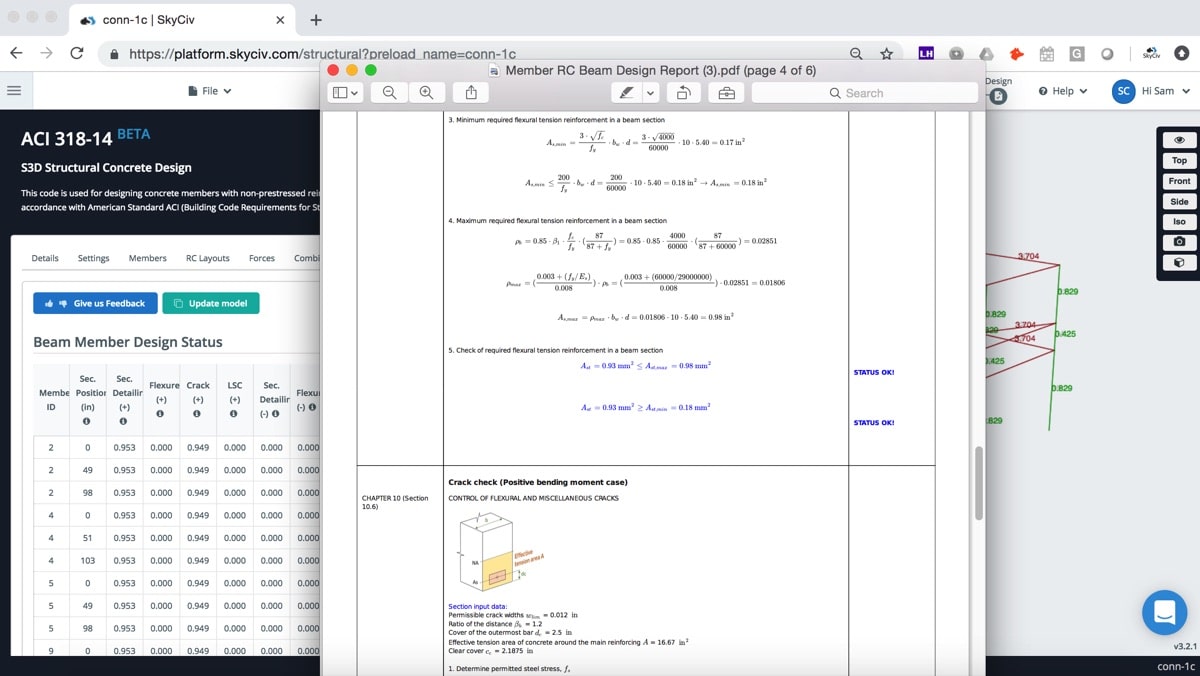私たちは皆、以前にそこに行ったことがある. あなたはプロジェクトに取り組んでいて、あまり馴染みのない材料や形状を使用して柱を設計しようとしています. ソフトウェアの設計チェックを実行すると、次の結果が返されます。 パス. しかし、結果にあまり自信がありません. 実際には, それに関していくつかの質問や懸念があります. そのため、手作業で計算を行ったり、ソフトウェアがその値を計算するために一体何をしているのかを理解しようとすることに、より多くの時間を費やすことになります。, あるいは、恐る恐る結果を額面通りに信じるか.
構造エンジニアとして、私たちは皆この痛みを経験しています. そこで私たちは業界に約束しました; 透明な構造設計ソフトウェアを作成する, 明確なステップバイステップのレポート付き. とても直感的に思える, しかしそれは私たちの業界に欠けているものです. 今日の記事では、徹底した設計レポートを提供するという SkyCiv の決定について検討します。, なぜそれが重要なのか、そしてそれがユーザーの作業をより速く、より明確に行うのにどのように役立つのか.
なぜオープンな設計レポートがあるのか?
自分のデザインに自信を持ってください
何よりもまず, ユーザーに結果に自信を持ってもらいたい. たくさんあります SkyCiv の QA 手順はこちら. しかしながら, ユーザーが結果を理解し、信頼することが依然として重要です, ソフトウェアの未知の内部動作に依存するだけではありません. 計算を追う能力, 参考文献と仮定, 安全かつ効果的な設計上の決定を行うための自信を与えます.

鉄筋コンクリート設計オープンレポートの例
また、エンジニアが盲目的に依存するリスクを回避するのにも役立ちました。 構造ソフトウェア. 設計レポートをレビューすることで、エンジニアは設計計算を段階的に確認できます。, 直観と経験をソリューションに適用しながら.
質問に早く答える
もう一つの問題点は何日も待つことだった (数週間ではないとしても!) ソフトウェア開発者が設計計算に関する質問に答えられるようにする. SkyCiv での価値提案の 1 つは、次のことに取り組んでいることです。 ユーザーに迅速に回答を提供する. これは、当社のリアルタイムの高速サポートからも明らかです。 独自のソリューションに直接統合 平均して 36 分の応答時間.
私たちは製品開発の早い段階で気づきました, エンジニアはソフトウェアがどのように動作するかについて疑問を持っている. 計算に使用される値? ソフトウェアが参照している設計コード条項はどれですか? どのようなロジックが使用されているか? これらの回答をユーザーに繰り返しメールで送信するのではなく、, 我々は考えた – なぜ計算だけ見せないのか?
APIのサポート
API は基本的にブラックボックスとして設計されています. データ入力, データ出力. しかしながら, 我々は考えた もっと良い方法があります. 私たちはまだあなたが望む答えを与えることができます, しかし、当社の設計ソフトウェアのオープンなレポートを通じて, 詳細な計算レポートも含めることができます.
したがって、API を介して, 2つの情報が届きます; (1) 最終結果 (2) PDFレポート, 段階的な計算を示す.
ホワイトボックス化されたソフトウェアはどれですか?
簡単に言うと、当社の設計ソフトウェアのほとんどはオープンになっているということです。, ステップバイステップの PDF レポート. 具体的には:
- 鋼部材設計ソフト – AISC, AISI, EN3, CSA, BS 5950
- RC設計ソフトウェア – ACI 318, なので 3600, EN2, CSA A23, BS 8110
- 接続設計 – AISC 360, EN3
- 風雪荷重ソフトウェア – ASCE, AS / NZ 1170, NBCC, EN1991
- 基礎設計ソフトウェア – ACI 318, なので 3600
オープンレポートの実際の動作をご覧になりたい場合は, このソフトウェアはすべて、 SkyCiv プロフェッショナルの無料トライアル 私たちのホームページから登録できます.
エンジニアが望むものを提供する
構造エンジニアとしてプロジェクトを承認する, あるいは、プロジェクトを上級 PE に引き継ぐことさえあります。, 自分の結果に自信を持つ必要がある. それだけではありません, 早く仕事ができるようになりたい, 必要な情報にすぐにアクセスできるようにすることで、.
全体, 結局のところ、構造エンジニアが望むものを提供することが重要だと思います. 業界はオープンな報告と透明性のあるデザインを求めています, そして私たちは企業としてこれを実現してきました. SkyCivを今すぐお試しください エンジニアが望むものを提供するという当社の取り組みを体験してください.
SkyCivのCEOおよび共同創設者
ベン (民事), BCom



